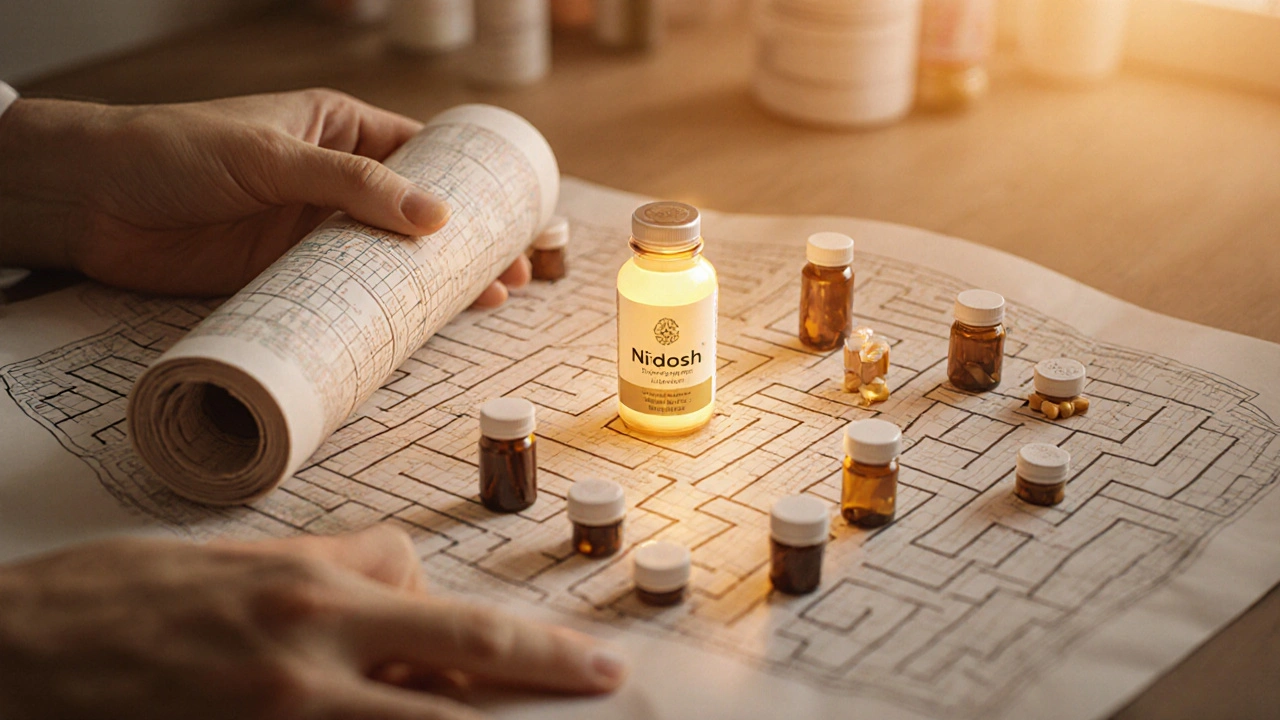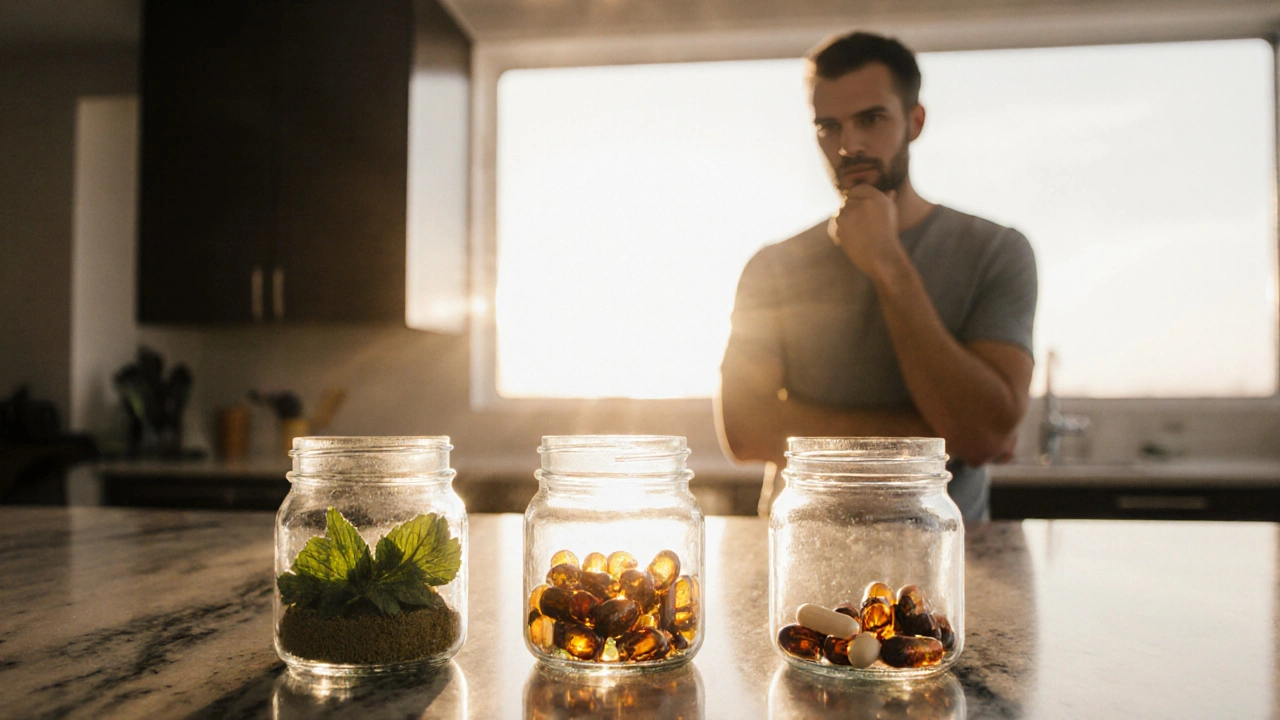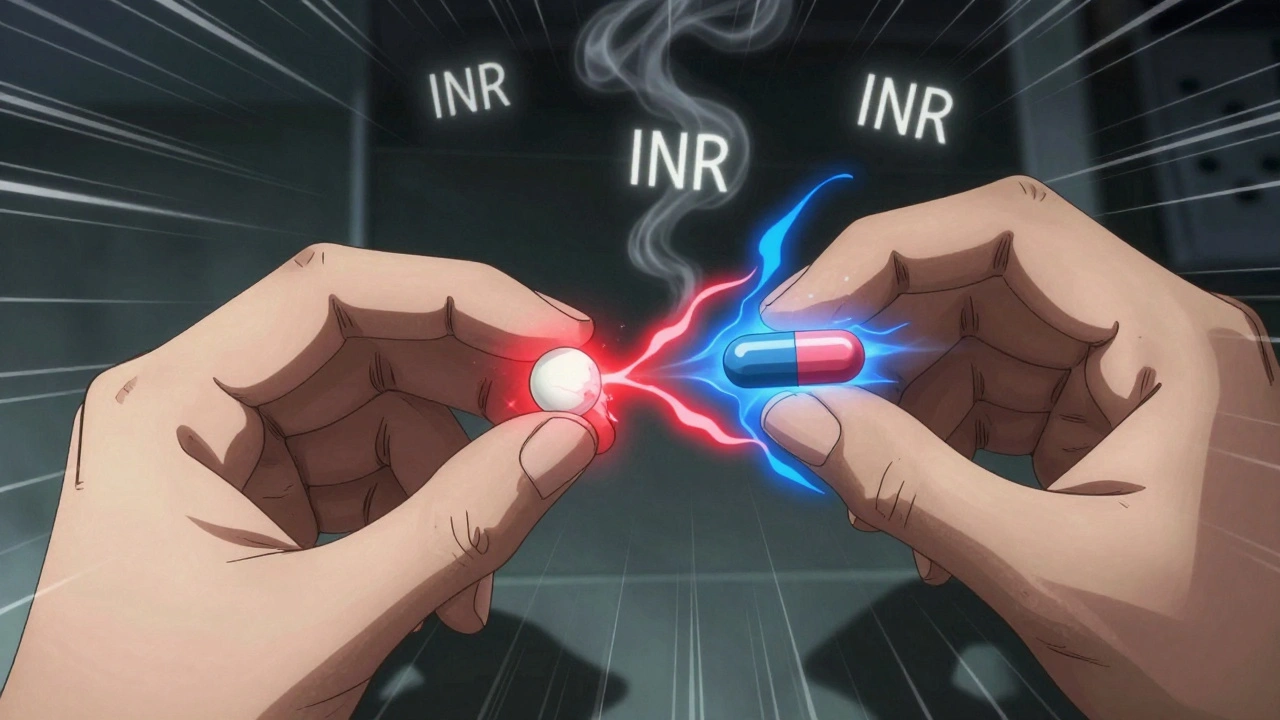Nirdosh Herbal vs Top Natural Alternatives: Detailed Comparison

Sexual Health Supplement Selector
This tool analyzes your priorities and health profile to recommend the most suitable sexual health supplement from the options discussed in the article. Answer the questions below to get personalized recommendations.
Your Priorities
Select the factors most important to you when choosing a supplement
Health Considerations
Select any health conditions or medications you're taking
Select your priorities and health considerations to see your personalized recommendation.
Choosing the right herbal supplement for sexual health can feel like navigating a maze of claims, ingredients, and price tags. If you’ve heard about Nirdosh herbal and wonder how it stacks up against other natural options, this guide breaks down the facts, compares the key players, and helps you decide which product fits your needs.
Key Takeaways
- Nirdosh herbal relies on a blend of traditional Indian herbs and claims a 30‑day boost in stamina.
- Alternatives like Maca Root, Ashwagandha, and Shilajit offer similar benefits but differ in potency, dosage, and side‑effect profiles.
- Prescription options such as sildenafil provide immediate results but come with stricter medical oversight.
- When comparing, focus on active ingredients, clinical backing, price per serving, and any known interactions.
- Start with the lowest effective dose and watch for any adverse reactions before committing long‑term.
What Is Nirdosh Herbal?
Nirdosh herbal is marketed as a natural male enhancement formula originating from Ayurvedic traditions. The label lists a blend of Ashwagandha (Withania somnifera), Safed Musli (Chlorophytum borivilianum), and Gokshura (Tribulus terrestris). Manufacturers claim that the combination supports testosterone levels, improves blood flow, and enhances endurance after a month of consistent use. A typical daily dose is two capsules delivering 500mg of total herb extract.
Top Natural Alternatives
Below are the most common herbal and mineral alternatives that consumers compare against Nirdosh.
- Maca Root - Peruvian tuber, often taken in 1,500mg capsules, known for energy and libido support.
- Ashwagandha - Adaptogen used for stress relief and testosterone maintenance; typical dose 600mg.
- Tribulus Terrestris - Plant extract aimed at increasing luteinizing hormone; common dose 250‑750mg.
- Shilajit - Mineral pitch from the Himalayas, rich in fulvic acid; daily dose 300‑500mg for stamina.
- Panax Ginseng - Asian ginseng, doses range 200‑400mg, linked to erectile function improvement.
- L‑Arginine - Amino acid that boosts nitric oxide; supplemental doses often 1‑3g.
- Zinc - Essential mineral for testosterone synthesis; 30mg daily is common.
- Sildenafil (Viagra) - Prescription PDE5 inhibitor, provides rapid erection support; 25‑100mg as needed.

Side‑by‑Side Comparison
| Attribute | Nirdosh Herbal | Maca Root | Ashwagandha | Shilajit | Panax Ginseng | L‑Arginine | Zinc | Sildenafil |
|---|---|---|---|---|---|---|---|---|
| Primary Actives | Ashwagandha, Safed Musli, Gokshura | Maca powder extract | Withania somnifera extract | Fulvic‑rich mineral pitch | Ginsenosides | L‑Arginine | Zn‑gluconate | Sildenafil citrate |
| Typical Dose | 2capsules (500mg) | 1 capsule (1,500mg) | 2 capsules (600mg) | 1 capsule (400mg) | 2 capsules (200mg) | 1 tablet (2g) | 1 tablet (30mg) | 1 tablet (25‑100mg) as needed |
| Time to Notice Effects | 30days consistent use | 2‑4weeks | 3‑4weeks | 2‑3weeks | 1‑2weeks | Within 1hour | 2‑4weeks | 30‑60minutes |
| Price per Month (AU$) | ≈38 | ≈25 | ≈30 | ≈45 | ≈40 | ≈20 | ≈12 | Prescription (varies) |
| Known Side‑Effects | Mild GI upset, rare allergy | Digestive discomfort | Drowsiness, thyroid impact | Metallic taste, rare rash | Insomnia, headache | Low blood pressure, GI bloating | Nausea at high doses | Vision changes, priapism (rare) |
| Clinical Backing | Limited small‑scale trials | Several randomized studies | Meta‑analysis of stress studies | Observational data | Moderate evidence for ED | Strong evidence for vasodilation | Well‑documented role in testosterone | Extensive FDA‑approved trials |
Decision Criteria: What Should Influence Your Choice?
- Active ingredient potency - Look for standardized extracts (e.g., 5% withanolides for Ashwagandha).
- Safety profile - Check for interactions with blood pressure meds or anticoagulants.
- Time to effect - If you need immediate results, a PDE5 inhibitor may be the only realistic option.
- Cost per therapeutic dose - Divide monthly price by the number of effective days.
- Regulatory status - Products registered with TGA (Australia) provide an extra layer of quality assurance.
Best‑For Scenarios
Looking for a gradual, hormone‑supporting boost? Nirdosh herbal’s blend of Ashwagandha and Safed Musli makes it a decent starter, especially if you’re already managing stress.
Need a quick, on‑demand solution? Sildenafil remains the only clinically proven, fast‑acting option, but you’ll need a prescription and a health check.
Prefer a single‑ingredient, well‑researched supplement? Maca Root or L‑Arginine offer clearer dosing and more robust study data.
Concerned about metal contamination? Choose Shilajit that has been independently certified for heavy‑metal safety.

Potential Side‑Effects & Safety Tips
Even “natural” doesn’t guarantee risk‑free. Here’s a quick safety cheat‑sheet:
- Start with half the suggested dose for any new herb.
- Monitor blood pressure if you combine vasodilators like L‑Arginine with prescription meds.
- Allergic reactions are rare but possible - stop immediately if you notice hives or swelling.
- Pregnant or nursing individuals should avoid most male‑enhancement blends.
- Keep supplements out of reach of children; accidental ingestion can cause GI upset.
Buying Tips: How to Spot a Quality Product
- Check the label for the exact percentage of active compounds (e.g., “Ashwagandha 5% withanolides”).
- Prefer brands that display third‑party lab results - a PDF certificate of analysis is a good sign.
- Verify that the manufacturer follows Good Manufacturing Practices (GMP).
- If you’re in Australia, look for the TGA’s “Listed Medicine” endorsement.
- Read recent user reviews for real‑world effectiveness and any recurring safety issues.
Frequently Asked Questions
Does Nirdosh herbal actually increase testosterone?
Small clinical trials reported a modest 8‑12% rise in free testosterone after 30days of use, but larger studies are still pending. Results can vary based on age and baseline hormone levels.
Can I take Nirdosh herbal together with Viagra?
Combining two vasodilators may cause unexpectedly low blood pressure. Consult a doctor before stacking any prescription erectile aid with herbal formulas.
How long does it take to see results from Maca Root?
Most users notice a boost in energy and libido within 2‑4weeks of daily 1,500mg dosing, though individual response times differ.
Is Shilajit safe for long‑term use?
When sourced from reputable suppliers and kept below 500mg daily, Shilajit is generally safe for up to 6months. Periodic liver function tests are advisable for extended use.
What should I do if I experience stomach upset?
Take the supplement with food, split the dose into two smaller servings, or switch to a capsule with a delayed‑release coating. If symptoms persist, discontinue and seek medical advice.
In the end, the “best” choice aligns with your timeline, budget, and health background. Nirdosh herbal offers a balanced, multi‑herb approach for gradual improvement, while single‑ingredient options or prescription meds cater to more specific needs. Use the comparison table, weigh the decision criteria, and start low-your body will tell you what works.






Comments
Teknolgy .com
October 14, 2025 AT 13:38Another day, another supplement hype. 🌿 If you think Nirdosh herbal is the holy grail, you might be reading the marketing brochure upside down. The reality? It's just another blend of herbs promising a mystical boost.
Caroline Johnson
October 17, 2025 AT 11:04This article is a pathetic parade of pseudo‑science, misinformation, and marketing fluff!!!
Megan Lallier-Barron
October 20, 2025 AT 08:31Sure, the comparison table looks nice, but we all know the internet loves a good placebo. 🌱 I’d argue that the real power lies in the mind’s expectation, not the herb itself.
Kelly Larivee
October 23, 2025 AT 05:58Looks like Nirdosh isn’t the only option. If you’re just curious, start with something simple like zinc – cheap and low risk.
Emma Rauschkolb
October 26, 2025 AT 03:24Wow, the whole thing reads like a sales pitch 😒. All those “clinical” claims sound more like marketing jargon than real science. :|
Kaushik Kumar
October 29, 2025 AT 00:51Hey folks, I get the skepticism, but if you’re already trying something, give it at least a month. Many of these herbs need consistent use to show any effect. Stay patient and track your own results.
Mara Mara
October 31, 2025 AT 22:18Patience? In America we demand results now! If you’re not seeing a change in two weeks, it’s time to ditch the “herbal nonsense” and look at proven options!!!
Jennifer Ferrara
November 3, 2025 AT 19:44Upon meticulous examination of the presented data, one must acknowledge that the comparative matrix, while exhaustive, suffers from a paucity of rigorous, peer‑reviewed substantiation. The reliance upon anecdotal reports, albeit compelling, fails to satisfy the stringent criteria demanded by contemporary pharmacological discourse. Furthermore, the absence of standardized extraction percentages for the listed botanicals renders any potency assessment speculative at best. It is also noteworthy that the cost analysis neglects the variable pricing structures inherent to different distribution channels, thereby obscuring true economic burden. The pharmacokinetic profiles of such phytochemicals remain largely undocumented, which raises legitimate concerns regarding bioavailability and metabolic interaction. Moreover, the omission of long‑term safety data, particularly in populations with comorbid conditions, is a glaring oversight that could jeopardize patient welfare. In contrast, prescription PDE5 inhibitors are buttressed by extensive phase‑III clinical trials, elucidating both efficacy and safety parameters across diverse demographics. The juxtaposition of such robust evidence against the tentative claims of herbal blends underscores a fundamental epistemological disparity. While the allure of “natural” solutions is undeniable, it should not eclipse the imperative for evidence‑based practice. Consequently, clinicians and consumers alike ought to prioritize supplements that are accompanied by transparent, reproducible research. Lastly, the table’s formatting, though informative, could benefit from clearer demarcation of statistical significance versus mere observational trends. In sum, a judicious approach mandating critical appraisal of source material is indispensable for informed decision‑making.
Terry Moreland
November 6, 2025 AT 17:11That was a solid read – thanks for laying it out. I’ll keep an eye on what the research actually says before trying anything.
Abdul Adeeb
November 9, 2025 AT 14:38Correction: The phrase "laid it out" should be "laid out" without the article "it." Additionally, "research actually says" would be more precise as "research actually indicates."
Abhishek Vernekar
November 12, 2025 AT 12:04Hey, don’t forget that personal experience matters too! 😊 If you’re feeling good, that’s a win.
Crystal Slininger
November 15, 2025 AT 09:31Let’s be honest, the whole supplement industry is a front for a shadow network funneling billions into covert research programs. The data they hide is more valuable than any open‑source study, and the real agenda is population control via subtle hormonal manipulation. Remember the 1998 “Nutrient Initiative” leak? That was just the tip of the iceberg.
Ben Poulson
November 18, 2025 AT 06:58While the concerns raised are certainly dramatic, it is important to request verifiable sources before accepting such assertions. Anecdotal claims without peer‑reviewed evidence do not constitute proof.